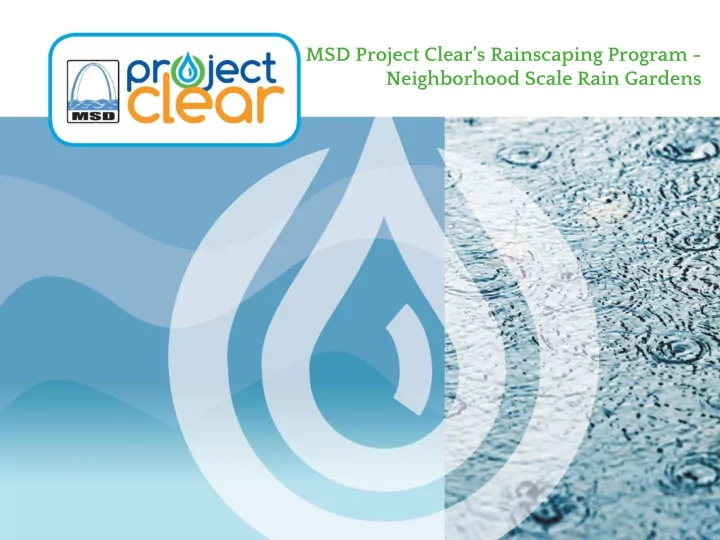

MSD Project Clear’s Rainscaping Program - Neighborhood Scale Rain Gardens
Outline • MSD Project Clear • Rainscaping Program Overview • Pilot Program Overview • Neighborhood Scale Raingardens – Siting – Design – Construction – Maintenance – Monitoring Susan McCrary, P.E., St. Louis MSD Matthew Koesterer, P.E., St. Louis MSD 2
MSD System Overview & Details Separate Sewer Area Combined Sewer Area 3
Example of Overflow in Combined Sewer System Background Combined sewers were built in the mid-19 th century, before MSD’s inception, to carry rainwater and sewage away from people’s homes. Reasons Combined Sewers Overflow • In dry weather sewers work fine. Sewage is treated at a treatment plant before being released back into the environment. • During heavy rainstorms, combined rainwater and sewage exceed capacity of sewer system and overflow into local waterways. • Overflows help keep sewers from flooding people’s streets and basements. 4
Build System Get the Repair & Improvement Rain Out Maintain s • Stormwater • System Maintenance • Tunnels Disconnections** • Storage Tanks • System Inspection • Rainscaping* • Relief Sewers • System • CitySheds Program* Rehabilitation and • High-Rate Replacement • Combined Sewer Treatment* • Fats, Oil and Grease Separations* Control Program • Emergency Response * Combined sewer area only activities 5 ** Separate sewer area only activities
Rainscaping Program • Green Infrastructure = Rainscaping • Combination of plantings, water features, catch basins, permeable pavements, and other activities that manage stormwater as close as possible to where it falls, rather than moving it someplace else. 6
Rainscaping Program Overview • $100 Million • Area that flows to CSO’s along the Mississippi River • Bissell Point service area • Mostly within the City of St. Louis 7
MSD Project Clear Rainscaping Programs (so far) EARLY ACTION PILOT SMALL GRANTS Pilot GRANTS • $3 million • Smaller projects • Before end of Pilot • 2011-2015 • Larger, regional • Individual projects landowners • Demonstration • Full MSD Plan • Approved by EPA projects as an “Early Review required • Monitoring Action” Project • EPA approves each • Education/Outreach • Budget: $150,000 • Budgeting $5 million • Plan for FULL for Model Round each year plus 1 st Round program • Some MSD projects, • Future Rounds? • Final report due Some grants We hope so! 8 12/31/2015 • 3 rd Round applications DUE 10/31/2014
Pilot Program Overview • First $3 Million • First 5 years (2011-2015) • Partnership with LRA • Demonstration Projects • Monitoring • Education/Outreach • Develop plan for Full GI Program • Final Report – DUE DECEMBER 31, 2015 (look for it on our webpage) 9
Pilot Program Progress • 221 Building Demolished (10 acres impervious removed + 175 Development Agreements) • 13 Planter Boxes (Habitat for Humanity) • 3 Site Scale Rain Gardens • 13 Demo Lots Amended Soil Tests 10
6 Neighborhood Scale Projects Clinton St. Rain Garden in Old North 11
Site Selection • Opportunity Study • GIS block study • Desktop review around demolitions • Field visits • Project ID Geraldine Ave. Rain Garden in Mark Twain Neighborhood – Curb bumpout • Ranking forebay • Coordination with City 12
Site Selection Lessons • LRA partnership • Topography • Development Agreements • Sewer capacity • Environmental concerns • Politics and community 13
Design – Neighborhood-scale • Phase 1 ESA & geotechnical investigation • All bioretention with IWS • Forebays • Some work in ROW • Pervious overlook (Clinton) • Detention (stacked & separate) • Watering hydrant (+$10k) • Aesthetics matter! 14
Construction • Phase II Stormwater BMP regulator review since 2006 • MSD had never built our own rain garden • MSD “master” specification changes • No pay items – lump sum per site with SOV Beacon Ave. Rain Garden in Walnut • Availability of materials Park East Neighborhood not a problem 15
Subsurface conditions • Abandoned foundations and walls • Building rubble = higher excavation cost • Over-excavate 2’ and geotextile fabric where rubble encountered 16
Construction Lessons • Coordination with plant designer • Inspector experience • Performance testing 17
Design for Maintenance • Trash • Forebay • Appropriate plants for wet AND DRY • Know who will maintain and skill level – routine vs. intensive • Groupings of same plant easier to know what to weed • Maintenance crews are important ambassadors! 18
Monitoring • Plan for during design • Difficult to get an “ideal” situation • Allow more time than you need (weather, equipment failures) • You need A LOT of data to establish relationships • Have a backup plan 19
20
Geraldine Ave. Rain Garden in Mark Twain 21
Beacon Ave. Rain Garden in Walnut Park East 22
Warne Ave. Rain Garden in O’Fallon 23
N. Vandeventer Ave. Rain Garden in JeffVanderLou 24
N. Sarah St. Rain Garden in The Ville 25
Clinton St. Rain Garden in Old North
Questions? • smccrary@stlmsd.com • mrkoesterer@stlmsd.com 27
Recommend
More recommend